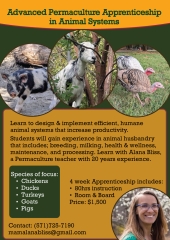posted 1 year ago
Congratulations! As far as "where to begin", the conceptual realm is a nice place. Here are a six great concepts to start with if you haven't already experienced them in your two years of learning:
1) 12 Principles of Permaculture - >
Very useful to have familiarity with Holmgren's twelve principles throughout the journey Observe and interact being the first principle. One of my favorites is to "integrate rather than segregate".
2) The "Scale of Permanence" - >
There is an order to doing things which avoids chaotic do-overs and miss steps. Do a site search here on the Scale of Permanence and be thinking and working down this scale. Some aspects of your site will literally be impossible to change (e.g. your climate or rainfall) while other things are more malleable (e.g. soil quality and life). Start at the top of the scale and then work down when possible.
3) Site Observation and Assessment - >
1) Reflect deeply on your own needs, capabilities and limitations.
2) Make a continuous list of site observations and later site assessments.
For example, an observation is "it's wet up over there" and an assessment could be "this may be a good place for a pond".
4) Analysis of Needs and Yields - >
Think about other elements (materials, plants, animals, structures, etc.) required to meet your needs. Consider all the inputs and output of each of those elements. Permaculture is very much about the beneficial assembly of these elements and materials, via patterning. Awesome things happen when you can pattern the outputs of one system with the inputs of another.
5) Designing by zones and sectors - >
Designing via zones and sectors is critical for larger sites, especially. But even with your 3 acre site, you'll find it helpful to conserve energy.
With respect to zones -- don't forget that the golden rule of permaculture is to start small, get an area under control, keeping things varied, and then expand. It's very frustrating to try to maintain an large area and never get ahead of natural succession. On the other hand, it is gratifying to have a small area well kept and productive.
With respect to sectors -- one of the most important yet overlooked sectors is the "human sector". Legal issues, personal or family limitations, financial constraints, trouble with neighbors. It can all affect the success of a site.
6) Site mapping - >
Having a base map, complete with legal boundaries, contours, utilities, roads, key elements, etc. can be a fun way to analyze a site. Then, drawing on and playing with the map can generate a lot of ideas, and help one discover ways to pack in productivity through permaculture patterning.
Have fun!









